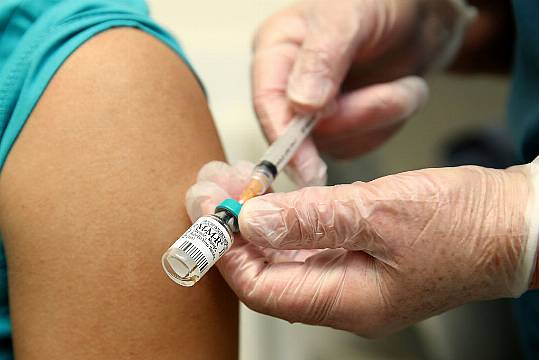A HSE risk assessment warned of a high risk of measles spreading in asylum seeker accommodation and direct provision centres as uptake for the vaccine across Ireland was described as “suboptimal”.
A presentation from the Health Protection Surveillance Centre (HPSC) said healthcare services were likely to come under significant pressure from the highly transmissible disease, which was very likely to cause outbreaks in non-immune populations.
The risk assessment said the lowest rates of vaccination were in counties Louth and Meath where immunisation rates were below 80 per cent, while uptake of below 85 per cent was reported in counties Sligo, Leitrim, and Donegal.
It said no local health office in the country had met the target of 95 per cent uptake of the MMR vaccine, which protects against measles, mumps, and rubella.
The slideshow said that a recent study had estimated that just over one in 10 people aged 18 to 34 were “non-immune” to measles.
This rose to a figure of 17.9 per cent for males that were aged either 18 or 19, indicating a “significant non-immune population” among adults.
The HSE said there was an “increasing likelihood” of measles taking hold in Ireland, particularly with the extent of travel between here and the United Kingdom.
This week, the HSE asked passengers who had travelled with Etihad Airways from Abu Dhabi arriving in Dublin Airport at 6.30am last Saturday to monitor themselves for symptoms because of a confirmed case on board. Higher-risk passengers, including pregnant women and the immunocompromised, were urged to contact health services.
Already, one person in the Midlands has died because of the illness while there have been several other suspected and confirmed cases.
The HSE risk assessment said: “The national immunisation uptake for both first and second dose of MMR [vaccination] is sub-optimal, and the young population also has a significant proportion of non-immune individuals.
“There are settings such as direct provision centres and asylum seeker accommodations where uptake is uncertain and transmission likelihood is very high.”
Outbreaks
It said outbreaks in non-immune populations were likely, which would in turn lead to a burden of disease with “morbidity and mortality”.
The risk assessment said a rapid mobilisation of measures including campaigns to encourage immunisation were needed to “curtail transmission”.
“The probability of introduction and transmission of measles in Ireland is high and the impact of the disease is high. This equates to a high risk of disease in Ireland,” it concluded.
The presentation also showed how vaccination rates in Ireland have fallen off over the past ten years.
In 2014, 93.1 per cent of people had received their MMR but by the second quarter of 2023, that figure had fallen to 89.2 per cent.
The risk assessment also detailed outbreaks across Europe in France, Austria, and in Romania where a national epidemic was declared in December of last year.
The presentation added: “The majority of cases in Romania were in unvaccinated children under nine years of age. There have been three deaths due to measles reported [there] including two deaths in children younger than seven months of age.”







